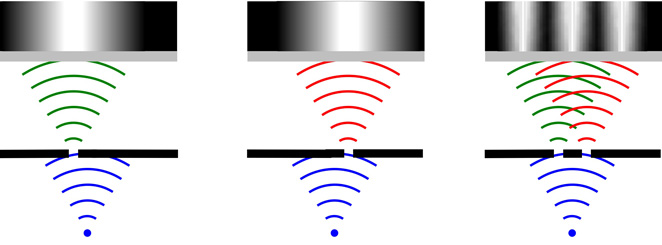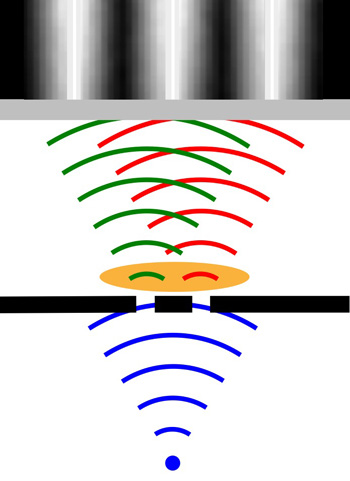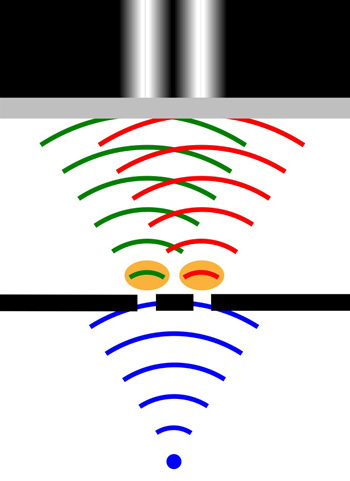|
Our last newsletter began exploring the most famous experiment of quantum mechanics, and perhaps all of physics.
Let’s recall some key points.
 In
these images, light waves (blue arcs) move upward from a source and hit
a black barrier with one or two slits. For clarity, light from the left
slit is shown in green, and from the right slit is shown in red.
However the frequency of all light is exactly the same. A gray strip of
film is exposed by light from the slits, with the intensity of light
reaching each point indicated by the white-brightness; the film is black
where no light arrives. In
these images, light waves (blue arcs) move upward from a source and hit
a black barrier with one or two slits. For clarity, light from the left
slit is shown in green, and from the right slit is shown in red.
However the frequency of all light is exactly the same. A gray strip of
film is exposed by light from the slits, with the intensity of light
reaching each point indicated by the white-brightness; the film is black
where no light arrives.
With one open slit, we see a broad white area, centered above that slit. With two slits open, we see interference fringes, alternating bands of constructive interference (white) and destructive interference (black), separated by partial interference (shades of gray).
The
black fringes are places that green waves would expose if only the left
slit were open, and that red waves would expose if only the right slit
were open. But with two ways to get there, no light arrives!
As the next images show, this same hallmark wave behavior also occurs if the light source is replaced by an electron source.

The
individual dots in the lower image — a 200-electron exposure — prove
electrons act as particles. The interference fringes in the upper image a
140,000-electron exposure — prove electrons also act as waves.
These images demonstrate the quantum principle of particle-wave duality — everything in nature has both particle and waves properties.
As
mentioned last time, wave interference occurs only among coherent
waves, waves of the same frequency that crest and trough synchronously
(with a fixed time delay between crests). To maintain coherence, the
electrons must be undisturbed from source to detector.
Let’s now introduce disturbance, the focus of this newsletter.
It
defies human intuition that a particle like an electron could traverse
two separated slits simultaneously. Who would believe a baseball could
split in half, cross on opposite sides of home plate, and then recombine
as a normal baseball at the catcher’s mitt? This must be a trick.
Can we peek behind the Wizard’s curtain, and discover the quantum trick?
Let’s outsmart quantum mechanics by finding out which slit each electron really goes through.
Let’s
shine light (shown in orange) on the exit-side of the barrier. Light
will bounce off electrons, and reveal which slit they pass through.
A critical aspect of our scheme is the wavelength of light we employ.
Let’s
start by being only slightly disturbing, using low energy, long
wavelength light. In the following images, the size of the orange
areas equals the wavelength of light employed.
 In
this image, light’s wavelength is larger than the slit separation. It
is a basic principle of optics that imaging resolution cannot be better
than the wavelength of the illuminating light. So this light will tell
us when an electron passes, but not which slit it passed through. Hence
we gain no information about the electrons, and wave interference
persists. In
this image, light’s wavelength is larger than the slit separation. It
is a basic principle of optics that imaging resolution cannot be better
than the wavelength of the illuminating light. So this light will tell
us when an electron passes, but not which slit it passed through. Hence
we gain no information about the electrons, and wave interference
persists.
Rats! Let’s use a shorter wavelength, and thus a higher energy.
 In
this image, a light beam illuminates each slit with a wavelength just
short enough to cover one slit. Now, we will know which slit each
electron traversed. In
this image, a light beam illuminates each slit with a wavelength just
short enough to cover one slit. Now, we will know which slit each
electron traversed.
But,
as the math proves, the wavelength at which we can identify the
traversed slit is exactly the wavelength at which interference vanishes.
[Here, for clarity, I reduced the width of the broad non-interference
exposure bands of the first image.]
Just when we know which slit electrons traverse, the quantum effect vanishes.
The physical reason for this is: observation changes the observed.
We cannot know where an electron is without smacking it with something —
here we use photons of light. The harder we smack (the shorter the
photon wavelength), the more precisely we know where it was, and the more its condition changes.
When
we hit an electron with a photon, the electron’s trajectory changes,
moving its impact point on the film. Since each electron’s impact point
shifts randomly, depending on smacking angles, the well-ordered
interference fringes are blurred. At the photon wavelength that just
reveals the traversed slit, the fringe blurring distance equals the
fringe separation. Electrons that would have hit a white fringe, if
undisturbed, become equally likely to hit a black fringe instead, so
interference fringes vanish.
In
our macro-world, random disturbances are continual and enormous
(relative to the quantum scale). This is why we rarely notice quantum
effects in our everyday lives — lasers are a key exception.
For
over 100 years, the world’s smartest physicists, led by Einstein, tried
to find a hole in this “weird” quantum theory — they all failed.
The mysterious inner workings of the quantum realm lie shrouded within an impenetrable veil.
A comprehensive analysis of the two-slit experiment, with all the math, is in my print books Quantum Mechanics and Feynman Simplified part3 and my ebook Feynman Simplified 3A.
|